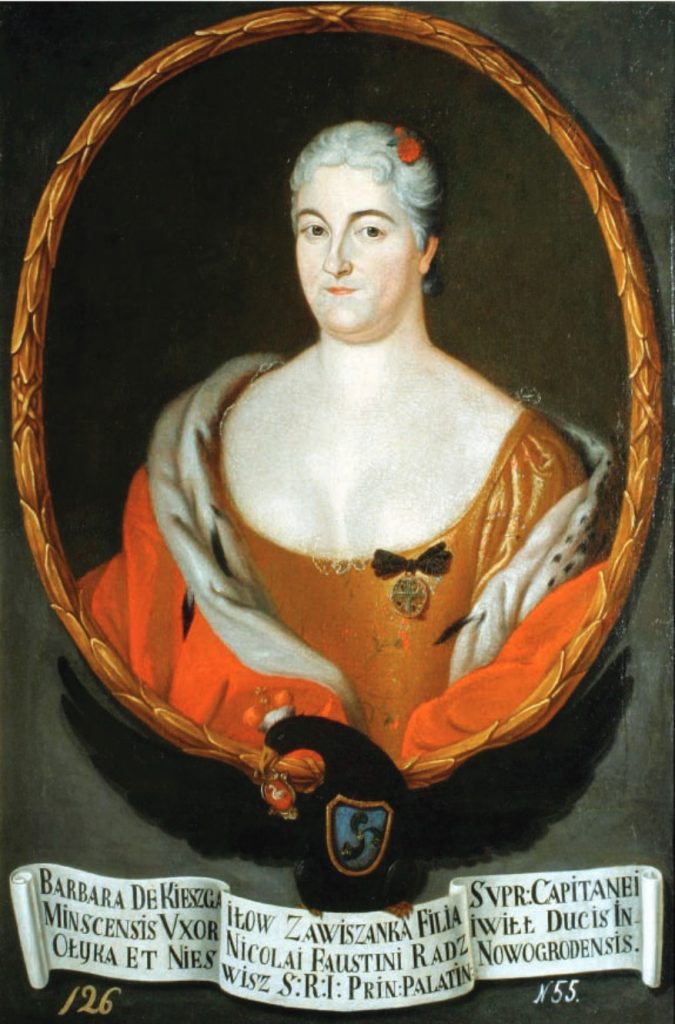Radziwiłłowa Barbara, née Zawisza
Barbara Radziwiłłowa, née Zawisza (3 XII 1690 – 15 II 1770)
Parents: Krzysztof Zawisza and Róża Tyszkiewicz
Husband: from 4 XII 1710 (wedding in Rohotna) Mikołaj Faustyn Radziwiłł (d. 2 II 1746), They had 14 children.
Barbara Radziwiłłowa, née Zawisza was once described as “very beautiful, fashionable, and industrious, a true daughter of her father Zawisza, Voivode of Minsk, the famous marshal of several diets” (pol. Pani niegdyś barzo piękna, modna i obrotna, nieodrodna od ojca swego Zawiszy, wojewody mińskiego, sławnego kilku sejmów marszałka, córka). She was one of the most politically active members of the Radziwiłł family. She was the dominant side of her marriage and made most of the decisions, motivating her husband’s actions. She was, alongside Anna Katarzyna Radziwiłłowa, née Sanguszko, one of the most important women in Lithuania at the time. Intelligent, resourceful, and industrious, together with her husband she belonged to one of the largest magnate families. Barbara Franciszka received the Star Cross on September 14, 1712. In 1733 she contributed to the creation of the confederation of the province of Nowogród, directed against the candidate for the throne, Stanisław Leszczyński. After Mikołaj Faustyn’s death Barbara continued to be involved in political matters.
The Court:
Barbara Radziwiłłowa was a benefactor of the Carmelite order, the founder of the Uniate church and the parish church in Berdyczów, which she generously furnished, the founder of liturgical paraments and rich church and monastery furnishings. After her husband’s death, Barbara managed extensive land property. After the death of her brother – Ignacy, Barbara took over Berdyczów (the town and surrounding villages). She also established numerous religious foundations at these estates (including, in particular, financial support for the Carmelites). Barbara’s political involvement and her numerous contacts with the most important figures in the Commonwealth brought fame, in particular, to her main residence in Zdzięcioł (the hereditary estate of Mikołaj Faustyn).
See also:
B. Popiołek, Najniższy podnóżek, sługai więzień pański– klientalne listy proszalne czasów saskich, Krakowskie Studia Małopolskie, nr 16/2011, s. 161 LINK
A. Penkała-Jastrzębska, „Prośba o jak najprędszą intencji swoich konkluzję”. Analiza materiałów źródłowych dotyczących magnackich pertraktacji przedślubnych (przykład małżeństwa Teresy Barbary z Radziwiłłów z Józefem Scipionem del Campo), ZNUJ Prace Historyczne, 2022, Numer 149 (1), p. 53-71 LINK
E. Pieczykolan, Szaty liturgiczne z fundacji księżnej Barbary Franciszki z Zawiszów Kieżgajłło Radziwiłłowej (1690-1770) w klasztorze oo. Dominikanów lubelskich, „Roczniki Humanistyczne”, Tom LXX, z. 4 – 2022, s. 137-162
 Women's noble court in the Polish-Lithuanian Commonwealth in the Saxon times. Structure, people, culture, functions
Women's noble court in the Polish-Lithuanian Commonwealth in the Saxon times. Structure, people, culture, functions

